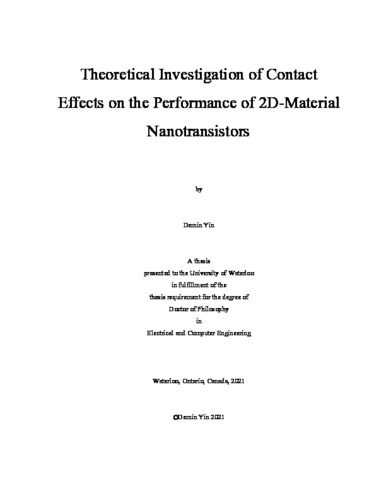| dc.description.abstract | Two-dimensional (2D) materials have attracted significant attention for electronic device applications since the first graphene transistor was demonstrated in 2004. Various 2D materials not only exhibit excellent carrier mobility and suitable bandgap, but also provide great opportunities for flexible and transparent device applications. However, the fabrication of high-performance 2D transistors is limited by various factors, such as unintentional doping, defects, and poor contact properties. In this study, some of the promising 2D materials, such as black phosphorus (BP) and molybdenum disulfide (MoS₂), and their electronic devices are studied. In particular, the contact effects on the performance of 2D material nanoscale transistors are explored by means of theory. Simulation methods for ohmic and Schottky contact in 2D-material field-effect transistors (FETs) are discussed in detail. Simulation settings in non-equilibrium Green’s function (NEGF) and boundary conditions in Poisson’s equation are specified. A quantum transport simulator is built to explore the performance of those devices with different types of contacts.
First, the effects of contact resistance (Rc) on the high-frequency performance limit of BP FETs are studied using self-consistent quantum simulations. A detailed comparison between intrinsic and extrinsic cut-off frequency (fT) and unity power gain frequency (fmax) is made. Unlike zero-bandgap graphene devices, semiconducting BP FETs exhibit clear saturation behaviors, which is critical for high fmax. It is shown that near THz frequency range of fT and fmax are highly promising for high-frequency applications, which is possible with an aggressive channel length scaling (Lch ≂ 10 nm) along with state-of-the-art fabrication techniques for low Rc. Our benchmarking against the experimental data indicates that there still exists large room for optimization of Rc.
Based on the recent temperature studies of 2D-material FETs, two different trends can be observed. We propose a model based on the effective mass approximation to explain the low-temperature current-voltage measurements of multilayer MoS₂ thin-film-transistors (TFTs). Our model suggests that the different temperature responses with Schottky and ohmic contacts result from various aspects of contacts, such as Schottky barrier height and barrier thickness. We also investigated the distinct device-to-device low-temperature responses in multilayer MoS₂ TFTs. Our comprehensive study provides a systematic scheme for the analysis of the contact properties in 2D material-based FETs.
Recently two-dimensional transition metal dichalcogenides (TMDs) lateral heterojunction field-effect transistors (FETs) have been demonstrated experimentally, in which metallic TMDs were used for the source/drain. We systematically investigate the contact property and device performance of monolayer 1T/1T’-2H MoS₂, MoSe₂, and MoTe₂ FETs. Schottky barrier (SB) heights are extracted from density functional theory calculations, and non-equilibrium Green’s function (NEGF) transport simulations have been performed to study device characteristics. Our simulation results reveal that ON and OFF-state characteristics of these devices are limited due to the inherent Schottky barrier. We optimize the performance of TMD lateral heterojunction SBFETs by using two different approaches: improving the electrostatic control by scaling equivalent oxide thickness and gate underlap and by moderately doping the gate underlap region. Our comprehensive study reveals that 1T’-2H MoTe₂ SBFET shows the highest ON current (~1 mA/µm) among the three with a reasonably small subthreshold swing (80 mV/dec) if properly scaled, while 1T-2H MoS₂ SBFET exhibits the highest Ion/Ioff (~10⁷) when Ohmic contact is established with moderate doping in the gate underlap region. This study not only provides physical insight into the electronic devices based on novel TMD heterostructures but also suggests engineering practice for device performance optimization in experiments.
We also investigate the geometric effect of contact in 2D heterojunctions. The electron transport through the interface has been simulated with the top-contact and side-contact 1T-2H MoS₂. We studied the five potential stacking modes in top-contact MoS₂ junctions. The accurate maximally localized wannier functions and Schottky barrier height in top and side contact junctions have been extracted for conductance calculation. The conductance comparison shows side contact is better than top contact in the 1T-2H MoS₂ heterojunction. The oscillations of conductance are observed with different 1T2H overlap lengths with a top contact. Also, it is compared with the strong conductance oscillation in the semiconducting mono-bi-monolayer black phosphorus (BP) heterojunctions. The current flow pattern of the 1T-2H MoS₂ junction shows that the majority of current transitions from 1T layer to 2H layer happen at the edge. We further modify the weak van der Waals interactions at the edge, suggesting a potential engineering method to achieve a better contact property in metal-semiconductor top-contact junctions. This study may help us better understand metal-semiconductor junctions in 2D materials.
Lastly, future works are suggested. The device simulations of top contact and side contact MoS₂ FETs are the next work to compare their device performance. There are huge numbers of novel systems in van der Waals 2D material heterojunctions. We can achieve tunneling FETs by engineering the band alignment between 2D materials with different bandgaps. In addition, with the developed simulator, vertical tunneling junctions can be investigated in layered 2D material systems. | en |

